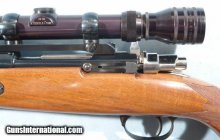The JCHiggins rifles were a great rifle and I liked to pick them up for the actions when I could. They were definitely a donor you didn't dare to shoot. I never saw one that didn't shoot well.
Here, in Canada, Eatons sold a rifle (The Eatons Model 100) which was their variation on the 51.The Eatons rifle was a Sako barreled action which featured and FN action with aluminum bottom metal, a Sako adjustable trigger, and a micro groove barrel (12 groove, as I recall). The barreled action was set into a really fat, homely, stock of walnut. On the bright side, there was plenty of wood to work with if you wanted to sleek it up a little!
I don't particularly like the Sako trigger but since it came that way, I've left it on mine. The FN actions are a very nice example of a commercial Mauser action. Polishing is good and surfaces are true. I rebarreled mine to 257 Roberts and reshaped and recheckered the stock. I had to add some length to it too. Apparently, the average Eatons customer was 5'6" and chunky instead of a lanky 6'1".
The Browning FN's were OK except that they were sometimes over polished. Also, that boltstop/ejector was as much a cost cutting measure as anything else.
There were a lot of variations. Triggers (two-stage military, single stage simple, one trigger was similar to the Winchester Model 70 trigger) standard bolt face, magnum boltface, full length magnum, single shot, and the Browning variants.
Like all Mausers, the FN's were most notable for their reliability, ruggedness, and simplicity. In general, I have always felt that every step away from the original 98 design was a step down the wrong path but the FN's were pretty solid, nonetheless.
I had one rifle come into the shop which showed the FN ability to take abuse. This had actually quit working. Pull the trigger and nothing happened. It was pretty rusty and, when I pulled it out of the stock, a 1/16" of wood came with it. The aluminum bottom metal was just powder and the trigger mechanism was rusted until it was seized. The pitting on the bottom of the receiver was incredible. I took the bolt apart and the striker spring was rusted nearly through. The barrel was, not surprisingly, pretty bad too. I took the trigger apart and cleaned it up, replaced the striker spring with one out of the junk box (the owner wanted to stretch that repair dollar) and put it back together. I scrubbed the barrel out with some steel wool and lapping compound. I covered the pitting on the sides of the receiver with some scotch tape so I could glop some epoxy around the recoil lug and gave it the world's cheapest glass bedding job. When it was all done, I took it out and shot it (open sights only) and it put Winchester factory loads into about 3 inches at 100yd. When the owner came in to pick it up, I told him I had never seen a rifle so badly rusted and asked if the rifle had ever been exposed to salt water. He said it had not but, when it had been frozen shut with snow packed around the action, he had thawed it out by urinating on the action. More than once. He hadn't cleaned it because "the rain washed it off". A rugged rifle, for sure.
On the opposite side of the coin, I had a fellow bring in two Olympic grade FN Brownings. He had been in a car accident and the rifles had gotten wet. He was on the way up to the hospital to drop his wife off to get her broken leg taken care and wanted to get the rifles looked after before they rusted.
When I first started BR shooting, in the mid-seventies one still saw the occasional single shot FN on the line. Usually in 22/250 or 308 and usually in unlimited guns. Most used Canjar triggers. WH











